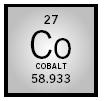Cobalt

MELTING POINT:
1,495°C
BOILING POINT
: 2,870°C
DENSITY
: 8.9 g/cm
3
MOST COMMON IONS
: Co
2+
, Co
3+
The name "cobalt" derives from the German word Kobold , meaning "mischievous spirit." Cobalt was first applied by sixteenth-century copper miners in the Hartz mountains of central Europe to gray metallic ores; this not only failed to produce copper when roasted, but also emitted dangerous fumes. It was found that the ores, after elimination of sulphur and arsenic by roasting, could be fused with sand to produce a blue glass called smalt. The source of the blue color, however, was not established until 1742, when Swedish chemist Georg Brandt isolated the previously unidentified metal cobalt.
Unlike its neighbors in the Periodic Table, iron, nickel, and copper, cobalt is not widespread in nature. It has an average abundance in Earth's crust of 25 parts per million (ppm); in ultrabasic rocks, where cobalt is most common, the average concentration is 110 ppm. Cobalt minerals may be concentrated by a range of geological processes to produce workable ores that typically contain 1,000–2,000 ppm.
Thirty-four cobalt minerals have been recognized, principally sulphides, selenides, arsenides, sulfarsenides, carbonates, sulfates, and arsenates. The main ore minerals are the sulfides linnaeite, carrolite, and cobaltiferous pyrite; the arsenides skutterudite and safflorite; the sulfosalt cobaltite; and the oxides asbolite (cobalt wad) and erythrite.
Cobalt has a wide range of industrial applications stemming from its variable oxidation states, color, and ability to form complexes. Its chief use, accounting for 45 percent of world demand, is in chemicals, particularly those used in catalysts, pigments, medical and agricultural agents, and nickel-cadmium (Ni-Cd) rechargeable batteries. Cobalt also has extensive metallurgical applications, including superalloys and other high temperature, erosion- and corrosion-resistant alloy steels.
SEE ALSO Magnetism .
C. Graham Smith
Bibliography
Evans, A. M. (1993). Ore Geology and Industrial Minerals: An Introduction , 3rd edition. London: Blackwell Science.
Smith, C. G. (2001). "Always the Bridesmaid, Never the Bride: Cobalt Geology and Resources." Transactions of the Institution of Mining and Metallurgy (Section B: Applied Earth Science) 110:B75–80.
Comment about this article, ask questions, or add new information about this topic: